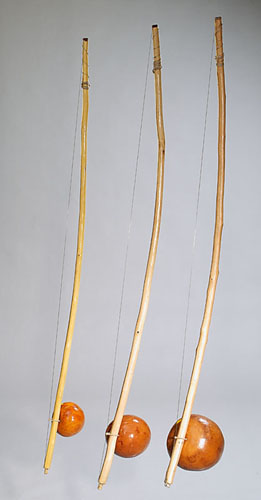Berimbau facts for kids
The berimbau is a cool musical instrument from Brazil. It's a type of musical bow with just one string, and you play it by hitting it, making it a percussion instrument. The berimbau first came from Africa, where it has many different names. Later, it became super important in a special Afro-Brazilian martial art called capoeira.
In capoeira, the berimbau is like the leader of the music. It tells the capoeira players, called capoeiristas, how to move in their game circle, known as the roda. If the berimbau plays fast, the capoeiristas move fast. If it plays slower, they move slower. It sets the whole rhythm for the game!
Contents
What is a Berimbau?
The berimbau is a simple but powerful instrument. It's made from a wooden bow, a gourd, and a single metal string. People play it by hitting the string with a small stick. They also use a coin or stone to change the sound. This makes the berimbau sound like many different instruments.
Parts of the Berimbau
A berimbau has a few main parts:
- Verga: This is the wooden bow part. It's usually made from a strong, flexible wood.
- Arame: This is the single metal string. It used to be made from wire from old car tires.
- Cabaça: This is a dried gourd. It acts like a sound box. It makes the sound louder.
- Baqueta: This is a small stick used to hit the arame.
- Dobão: This is a coin or a flat stone. Players press it against the arame to change the notes.
- Caxixi: This is a small shaker basket. Players hold it in the same hand as the baqueta. It adds a rattling sound.
How to Play the Berimbau
Playing the berimbau takes practice. The player holds the verga with one hand. They use the baqueta to hit the arame. With the other hand, they hold the dobão against the arame. Moving the dobão changes the pitch of the sound. The cabaça is pressed against the player's stomach. Moving it away and towards the body also changes the sound. This creates a buzzing, rhythmic sound.
Berimbau's History and Origin
The berimbau's roots are in Africa. Similar musical bows have been played there for thousands of years. When enslaved people were brought to Brazil, they brought their culture and music with them. The berimbau became an important part of Afro-Brazilian culture. It helped keep traditions alive.
Berimbau and Capoeira
The berimbau is the most important instrument in capoeira. Capoeira is a mix of martial arts, dance, acrobatics, and music. The berimbau leads the roda, which is the circle where capoeiristas play. The rhythm played on the berimbau tells the players what kind of game to play. It can be fast and aggressive or slow and tricky.
Types of Berimbau in Capoeira
In a capoeira roda, there are usually three types of berimbau, each with a different sound:
- Gunga: This is the largest berimbau. It has the deepest sound. The gunga sets the main rhythm for the game.
- Médio: This is the middle-sized berimbau. It plays a rhythm that supports the gunga.
- Viola: This is the smallest berimbau. It has the highest sound. The viola plays faster, more complex rhythms. It adds flair to the music.
Images for kids
See also
 In Spanish: Birimbao para niños
In Spanish: Birimbao para niños




